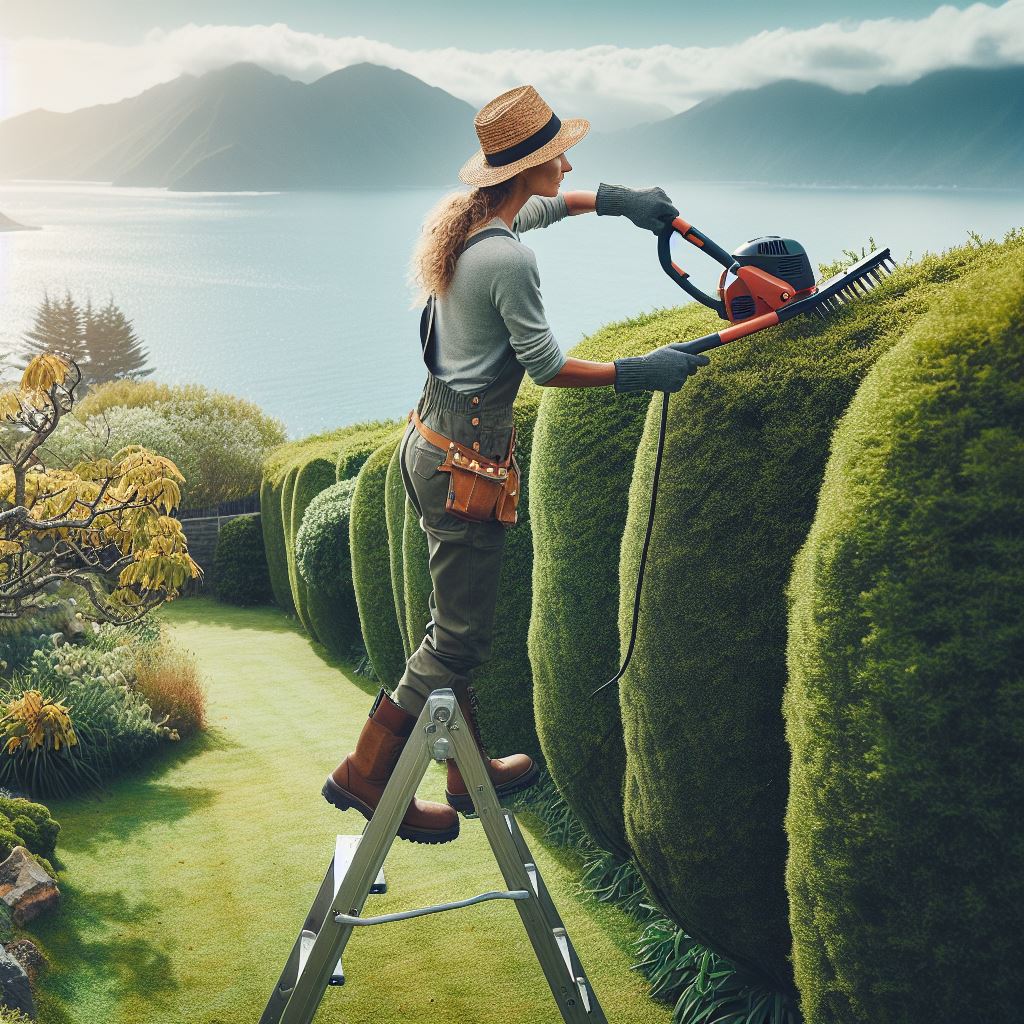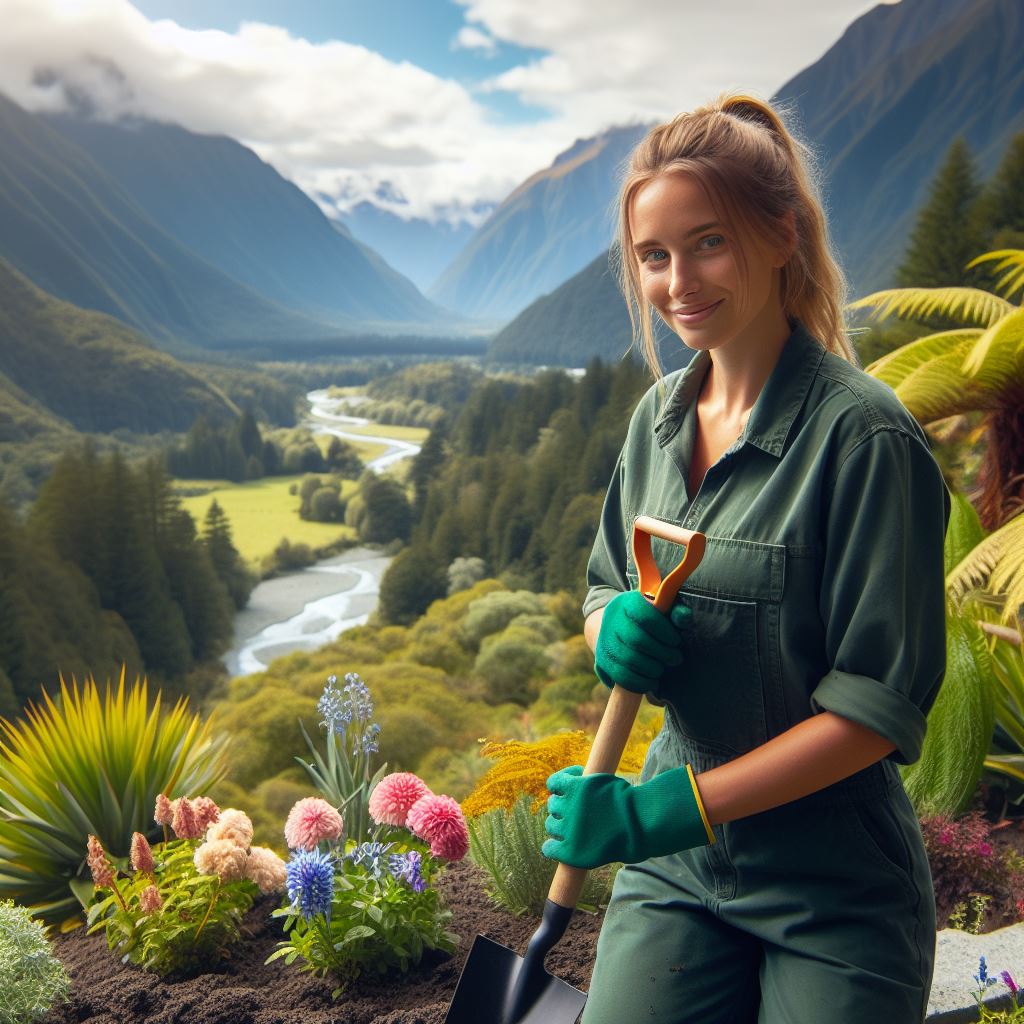Introduction
Discover the latest trends shaping New Zealand’s landscaping scene as we step into 2024 with excitement and innovation.
From lush residential gardens to urban spaces, landscaping is undergoing dynamic transformations, reflecting contemporary aesthetics and environmental consciousness.
In this section, we explore the cutting-edge trends that redefine outdoor spaces and inspire landscaping enthusiasts nationwide.
New Zealand’s unique topography and diverse climate set the stage for a vibrant and ever-evolving landscaping tapestry.
As we navigate through the landscape design trends of 2024, we witness a fusion of traditional practices and modern sustainability principles.
The use of native plants takes center stage, celebrating the country’s rich biodiversity and promoting ecological balance.
Outdoor living spaces are becoming extensions of interiors, seamlessly blending comfort, functionality, and aesthetic appeal.
Smart technology integration is revolutionizing landscaping, offering automated irrigation systems, lighting controls, and even app-controlled garden monitoring.
Vertical gardens are gaining popularity in urban areas, maximizing space and introducing a touch of greenery to concrete environments.
Sustainable and recycled materials are preferred choices, contributing to eco-friendly designs and reducing environmental impact.
Edible landscapes are on the rise, with homeowners incorporating fruit and vegetable gardens into their outdoor spaces, fostering a connection to nature and sustainable living.
Customization is key, as landscaping trends focus on tailoring designs to individual preferences, creating unique and personal outdoor sanctuaries.
Water features, from minimalist ponds to contemporary fountains, add a sense of tranquility and visual interest to outdoor settings.
Artificial intelligence and robotics are making their mark in landscaping maintenance, enhancing efficiency and precision in tasks like mowing and pruning.
As we delve into the hottest landscaping trends of 2024, it becomes evident that sustainability, technology, and personalization are at the forefront of design considerations.
Personalized Career Consulting
Unlock your potential with expert career advice tailored to your goals. Get personalized guidance and actionable steps toward your dream career in New Zealand.
Get StartedThe integration of these trends not only elevates the visual appeal of outdoor spaces but also aligns with the growing emphasis on eco-conscious and technologically advanced landscaping practices.
Join us on this exploration of the trends that are shaping New Zealand’s landscapes, turning ordinary spaces into extraordinary outdoor retreats.
Sustainable Landscaping
In recent years, there has been an increasing focus on sustainability in landscaping.
The need to preserve our natural resources and reduce our environmental impact has become a significant driving force behind landscaping trends.
People are now more conscious of the choices they make when designing their outdoor spaces, ensuring that they contribute to a greener and more sustainable future.
Using Native Plants
- Native plants are gaining popularity in landscaping as they are well-adapted to the local climate and require minimal maintenance.
- By using native plants, homeowners can create vibrant and diverse landscapes, while also supporting the local ecosystem and conserving water.
- These plants are typically more resistant to pests and diseases, reducing the need for chemical treatments.
Rainwater Harvesting
- Rainwater harvesting has become a common practice in sustainable landscaping.
- By collecting rainwater in barrels or tanks, homeowners can use this free resource to water their plants and reduce their reliance on municipal water supplies.
- This not only conserves water but also helps to prevent runoff and erosion.
Incorporating Solar-Powered Features
- Solar-powered features such as outdoor lighting, water pumps, and irrigation systems are becoming increasingly popular.
- Not only do they reduce energy consumption and lower utility bills, but they also minimize the carbon footprint associated with maintaining a landscaped area.
- By harnessing the power of the sun, homeowners can create a more environmentally friendly outdoor space.
Conserving Resources
- Sustainable landscaping focuses on conserving resources such as water, energy, and materials.
- Efficient irrigation systems, including drip irrigation and smart controllers, help minimize water waste.
- Using recycled or upcycled materials for hardscaping and choosing locally sourced materials reduce the carbon footprint associated with landscaping projects.
Supporting Biodiversity
- Creating landscapes that support biodiversity is another key aspect of sustainable landscaping.
- By choosing a variety of plants that attract birds, butterflies, and beneficial insects, homeowners can contribute to the local ecosystem.
- Providing habitats and food sources for wildlife is essential for maintaining a balanced and healthy environment.
Basically, the increasing focus on sustainability in landscaping is evident in the adoption of eco-friendly practices such as using native plants, rainwater harvesting, and incorporating solar-powered features.
Creating landscapes that conserve resources and support biodiversity has become essential in designing outdoor spaces.
As we move forward into the future, it is crucial to continue promoting and implementing sustainable landscaping practices to ensure a greener and more harmonious relationship with our natural surroundings.
Read: Residential vs Commercial: NZ Electrician Roles
Outdoor Living Spaces
Growing trend of creating functional outdoor living spaces
In recent years, there has been a growing trend in creating functional outdoor living spaces in New Zealand.
These spaces are designed to provide a seamless transition from indoor to outdoor living and offer a place to relax, entertain, and enjoy the beautiful New Zealand scenery.
Popularity of outdoor kitchens, fire pits, and comfortable seating areas
One of the most popular features of outdoor living spaces is the outdoor kitchen. Gone are the days of using a basic barbecue to cook outside.
Now, homeowners are investing in fully equipped kitchens that rival their indoor counterparts. These outdoor kitchens often feature built-in grills, sinks, refrigerators, and even pizza ovens.
Another hot trend in outdoor living spaces is the inclusion of fire pits. These features not only provide warmth during colder months but also create a cozy ambiance for gatherings.
Fire pits can range from simple portable models to elaborate built-in structures that become the centerpiece of the outdoor space.
The rise in demand for outdoor entertainment areas to enjoy the beautiful New Zealand scenery
Comfortable seating areas are also a must-have in outdoor living spaces. Gone are the days of uncomfortable outdoor furniture.
Now, homeowners are investing in high-quality, weather-resistant seating options that are just as stylish and comfortable as their indoor counterparts.
From sofas and lounge chairs to outdoor dining sets, there are endless options to choose from.
In addition to the desire for functional and comfortable outdoor living spaces, there has also been a rise in demand for outdoor entertainment areas.
Homeowners want to be able to enjoy the beautiful New Zealand scenery while watching their favorite sports events or movies.
This has led to the increasing popularity of outdoor televisions and sound systems that are designed to withstand the elements.
Furthermore, outdoor entertainment areas are not just limited to watching television.
Homeowners are also creating outdoor theaters complete with projectors and screens, providing a unique and immersive movie-watching experience.
These outdoor theaters often include comfortable seating, cozy blankets, and even popcorn machines.
Overall, the trend of creating functional outdoor living spaces in New Zealand is continuing to grow in popularity.
From outdoor kitchens and fire pits to comfortable seating areas and outdoor entertainment areas, homeowners are investing in creating spaces that allow them to make the most of their outdoor environment.
Whether it’s enjoying a meal with family and friends, gathering around a fire pit on a cool evening, or watching a movie under the stars, the possibilities for outdoor living are endless.
Read: Electrical Code Updates 2024: What NZ Needs to Know
Natural and Native Landscapes
In recent years, there has been a significant shift in landscaping trends towards embracing natural and native landscapes.
Gone are the days when manicured lawns were the ultimate goal. Today, homeowners and landscape designers prefer a more organic and sustainable approach to outdoor spaces.
Let’s delve into this rising trend and explore its key elements.
Transform Your Career with a Professional CV and Cover Letter
Stand out to employers with an ATS-optimized resume and tailored cover letter designed to match your dream role. Let us craft your job application materials for success!
Get StartedPreference for Natural and Native Landscapes
One of the primary reasons behind the growing preference for natural and native landscapes over manicured lawns is the desire for a low-maintenance and sustainable outdoor environment.
Native plants and grasses, which are adapted to local climates, require less watering and are generally hardier, making them ideal choices for homeowners looking to reduce water consumption and maintenance costs.
Moreover, natural landscapes that mimic the surrounding environment create a harmonious connection between the property and its surroundings.
Rather than standing out as an artificial oasis, a well-designed natural landscape seamlessly integrates with the local ecosystem, enhancing biodiversity and supporting local wildlife populations.
Popularity of Native Plants and Grasses
The popularity of using native plants and grasses in landscaping has soared in recent years. These plants not only add a unique beauty to outdoor spaces but also offer a range of benefits.
Native plants are more adapted to local conditions, often requiring less fertilization, fewer pesticides, and less water compared to exotic species.
This not only saves time and money but also reduces the ecological footprint associated with maintaining traditional gardens.
Furthermore, native plants provide habitat and food for native pollinators and birds, contributing to the conservation of local ecosystems.
In addition to their ecological benefits, native plants offer diverse textures, colors, and fragrances, adding a sense of place and authenticity to the landscape.
From vibrant wildflowers to majestic ferns, native plants bring a touch of wild beauty to any garden.
The increasing availability of native plant nurseries and the growing awareness among homeowners about the benefits of using them have fueled this trend.
Incorporating Natural Elements
To achieve a more organic look, landscape designers are increasingly incorporating natural elements into their designs.
Rocks, boulders, and water features are becoming popular additions to outdoor spaces, adding a sense of tranquility and creating focal points in the landscape.
The use of natural materials like stone and wood in pathways, seating areas, and retaining walls further enhances the natural aesthetic and provides a seamless transition between the built environment and the surrounding nature.
By incorporating natural elements, outdoor spaces gain a sense of timelessness and create a connection with the natural world.
Whether it’s a meandering stone pathway leading to a serene water feature or a boulder grouping showcasing native plants, these elements instill a feeling of calmness and serenity in the garden, thereby enriching the overall outdoor experience.
Therefore, the shift towards natural and native landscapes in New Zealand reflects a growing desire for sustainable and low-maintenance outdoor spaces that harmonize with the local environment.
The preference for native plants, grasses, and natural elements not only reduces water consumption and maintenance costs but also supports local ecosystems and enhances biodiversity.
As this trend continues to evolve, we can expect more homeowners to embrace the beauty and benefits of a natural and native landscape.
Read: Women in Electrical Trades: NZ’s Growing Trend
Low-Maintenance Gardens
In recent years, there has been a growing interest in low-maintenance gardens, as homeowners look for ways to simplify their outdoor spaces.
Artificial Turf
- One trend that is gaining popularity is the use of artificial turf.
- Artificial turf provides a lush, green lawn without the need for regular mowing and watering.
- It also eliminates the need for harmful pesticides and fertilizers, making it an eco-friendly option.
Drought-Tolerant Plants
- Another aspect of low-maintenance gardens is the use of drought-tolerant plants.
- These plants require less water and can survive in dry conditions, reducing the need for constant watering.
- They also come in a variety of colors and textures, adding visual interest to the landscape.
Efficient Irrigation Systems
- To further minimize maintenance, homeowners are opting for efficient irrigation systems.
- These systems use technology to deliver water directly to the plants’ roots, reducing water waste.
- They can also be programmed to water the garden at specific times, ensuring plants receive adequate hydration.
By incorporating artificial turf, drought-tolerant plants, and efficient irrigation systems, homeowners can create landscapes that require minimal upkeep.
This allows them to spend more time enjoying their outdoor spaces, rather than constantly maintaining them.
Low-maintenance gardens provide a practical solution for busy individuals who still want to have a beautiful and functional outdoor area.
These gardens not only save time and effort but also contribute to environmental sustainability by reducing water consumption and minimizing the use of harmful chemicals.
In 2024, we can expect low-maintenance gardens to continue growing in popularity as more homeowners recognize the benefits they offer.
Boost Your Career with a Standout LinkedIn Profile
Attract recruiters and expand your network with a fully optimized LinkedIn profile tailored to highlight your strengths and professional goals. Let your profile open doors to new opportunities!
Get OptimizedSo, if you’re looking to create an outdoor space that is both beautiful and easy to maintain, consider incorporating these trends into your landscape design.
Your garden will thank you, and so will your free time!
Read: Apprenticeships in Electrical Work: NZ Focus

Vertical Gardening
Vertical gardening techniques have become increasingly popular in recent years. This trend is expected to continue to rise in popularity in New Zealand in 2024.
Vertical gardening is a creative way to maximize limited space and create a stunning visual display. It involves the use of living walls, hanging planters, and trellises to grow plants vertically instead of horizontally.
Exploring the Increasing Popularity
Vertical gardening has gained traction among gardening enthusiasts and urban dwellers due to several reasons.
Firstly, it allows people with limited space to still enjoy the benefits of gardening.
Many city residents have small balconies or patios, and vertical gardening allows them to grow plants without taking up valuable floor space.
Furthermore, vertical gardens are aesthetically pleasing and can transform any dull space into a vibrant oasis. They can be designed in various creative and artistic ways, adding a unique touch to any environment.
With the increasing interest in sustainable living, vertical gardening also promotes eco-friendly practices by utilizing recycled materials for planters and reducing water consumption.
Living Walls, Hanging Planters, and Trellises
Living walls are a popular vertical gardening technique where plants are grown directly on a wall surface.
They can involve different types of plants and are a fantastic way to create a stunning visual effect, transforming walls into living canvases of greenery.
These walls not only beautify a space but also provide insulation, reducing energy costs.
Hanging planters are another ingenious solution for vertical gardening.
They are ideal for small spaces and can be hung from railings, walls, or ceilings. Hanging planters add depth and dimension to an area and can be easily rearranged for different visual effects.
Trellises are vertical structures that provide support for climbing plants such as vines and roses. They can be used to create green walls, fences, or archways.
Trellises are not only functional but also add charm and character to outdoor spaces.
The Benefits of Vertical Gardening
Vertical gardening offers numerous benefits beyond saving space. Firstly, it allows for better air circulation in urban environments, improving air quality.
Plants naturally filter pollutants, reducing the impact of harmful toxins in the air.
Additionally, vertical gardens can provide insulation to buildings, reducing heat gain and loss.
This feature not only helps regulate indoor temperatures but also contributes to energy efficiency, resulting in lower energy bills.
Vertical gardens also contribute to biodiversity in urban areas by creating habitats for birds, insects, and other wildlife. They provide a haven for pollinators and can help mitigate the loss of green space in cities.
Essentially, vertical gardening techniques are projected to be hot trends in New Zealand’s landscaping industry in 2024.
The increasing popularity of this gardening method can be attributed to its ability to maximize limited space, improve air quality, and provide insulation to buildings.
Whether it’s through living walls, hanging planters, or trellises, vertical gardening is a sustainable and visually appealing way to bring greenery into urban environments.
Read: The Impact of Technology on NZ Electricians
Conclusion
Wrap up the blog post by summarizing the key landscaping trends for 2024 in New Zealand
As we look ahead to 2024, several key landscaping trends are set to dominate outdoor spaces in New Zealand.
From the use of native plants to creating sustainable and eco-friendly designs, there are plenty of exciting ideas to incorporate into your own backyard.
Encouragement to incorporate these trends into their own outdoor spaces
By embracing the popularity of outdoor entertaining, including cozy outdoor living areas and innovative lighting solutions, you can create a space that is not only visually pleasing but also functional.
Incorporating water features and organic materials such as wood and stone can bring a natural and calming element to your landscape.
Importance of aligning landscaping choices with personal preferences, climate, and local regulations
It’s important to remember that personal preferences, climate, and local regulations should always guide your landscaping choices.
While following trends can be inspiring, it’s essential to make sure they align with your own style and the practicalities of your location.
By incorporating these landscaping trends, you can create an outdoor space that embraces the beauty of New Zealand’s natural environment while also reflecting your unique personality and lifestyle.
So, whether you’re starting from scratch or looking to update your existing outdoor space, don’t be afraid to experiment with these trends and make them your own.
Let 2024 be the year you transform your backyard into a stunning oasis that combines the best of nature, design, and personal style.




